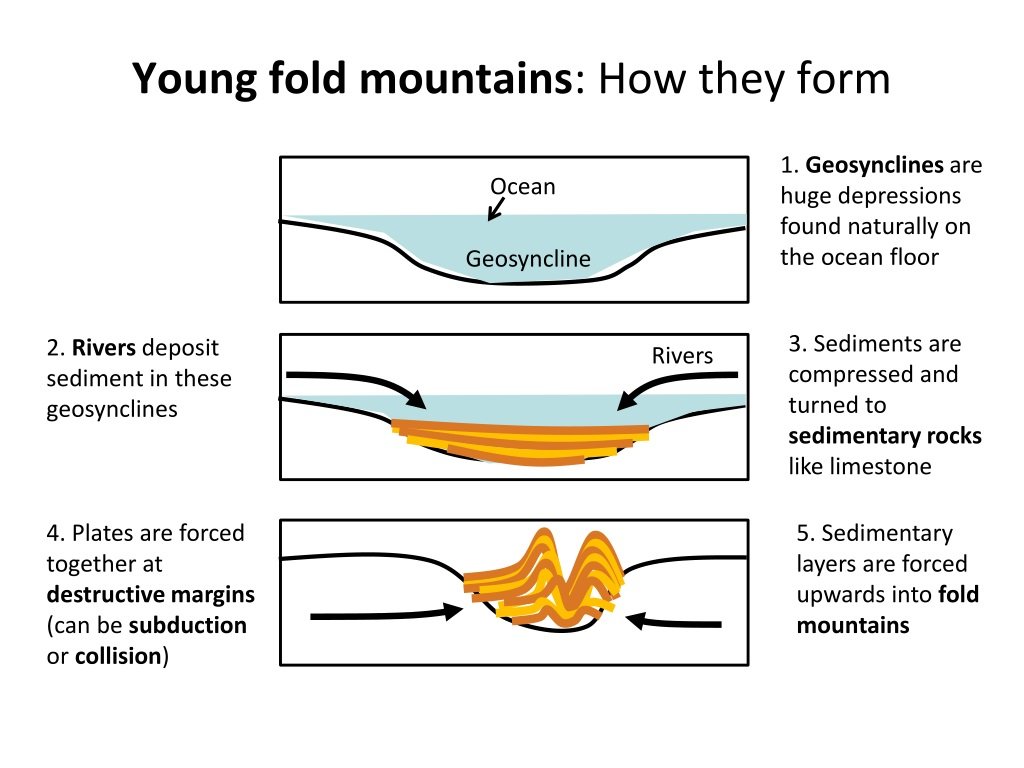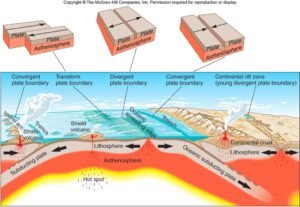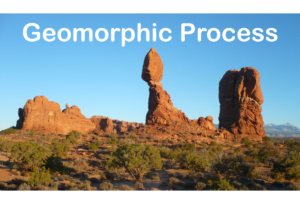Introduction
Before the rise of plate tectonics, it was one of the central ideas used to explain the origin of mountain ranges, sedimentary basins, and structural features of the Earth’s crust. A geosyncline refers to a large-scale, elongated trough or depression in the Earth’s crust that gradually subsides and accumulates thick sequences of sediments over a long geological period. These sediments later undergo folding, faulting, and metamorphism to form mountain belts. In this article, we’ll explore the historical development of the geosyncline concept, its types, stages of formation, real-world examples, and its relevance in modern geology.
Historical Development of the Geosyncline Concept
The idea of geosyncline first appeared in the 19th century when geologists were trying to explain how thick piles of sediments turned into mountains. The German geologist James Hall (1859) and American geologist James Dwight Dana were among the first to propose that long, subsiding regions of the crust accumulated sediments which later folded into mountain chains.
Later, Austrian geologist Eduard Suess and French geologist Marcel Bertrand expanded the concept, making it central to the geosynclinal theory of mountain building. In the early 20th century, Hans Stille refined the classification of geosynclines and linked them with orogenic (mountain-building) events. For decades, this concept dominated geological thought.
It was only in the 1960s, with the advent of plate tectonics, that geologists found a more dynamic and unifying explanation for mountain building and basin formation. Still, geosynclinal theory laid the groundwork for many of the observations and ideas that contributed to the development of modern tectonics.

Types of Geosyncline
Geosynclines were classified into several types based on their structural and sedimentary characteristics. The most commonly accepted types include:
1. Eugeosyncline
A eugeosyncline is the deeper and more unstable part of a geosynclinal basin, typically situated on the oceanward side, where thick sequences of volcanic rocks, graywackes, cherts, and deep-water sediments accumulate. It is marked by intense tectonic activity, subsidence, and volcanism, often associated with island arcs and oceanic trenches. During mountain-building processes (orogeny), eugeosynclines are compressed, folded, and metamorphosed, giving rise to complex igneous and metamorphic rock assemblages that form the core zones of many major orogenic belts.
2. Miogeosyncline
A miogeosyncline is the shallow, stable part of a geosynclinal basin, usually located on the continental side, where thick sequences of shallow-water sediments such as sandstones, shales, and limestones accumulate. Unlike eugeosynclines, miogeosynclines are relatively less affected by volcanism and deep-sea deposits, instead recording quiet marine sedimentation over long periods. During orogeny, the sediments of miogeosynclines are deformed, folded, and uplifted to form parts of mountain ranges, often representing the more sedimentary-rich outer zones of orogenic belts.
3. Taphrogeosyncline
A taphrogeosyncline is a type of geosyncline that forms mainly due to fault-controlled subsidence, creating a long, narrow, and deep trough where sediments and volcanic materials accumulate. Unlike the broad downwarping of typical geosynclines, taphrogeosynclines develop from tectonic block faulting, which produces steep, fault-bounded depressions. These basins often receive both continental and marine sediments along with volcanic rocks and may later become important sites of orogenic activity, where they are deformed and uplifted to form mountain belts.
4. Orthogeosyncline
An orthogeosyncline is the classic or typical form of a geosyncline, usually elongated and aligned parallel to continental margins or mountain belts, where a very thick sequence of sediments and volcanic rocks is deposited over a long geological time. It commonly consists of both miogeosynclinal (shallow-water, stable side) and eugeosynclinal (deep-water, unstable side) facies within the same basin. Orthogeosynclines play a major role in orogeny, as the accumulated sediments are later compressed, folded, and metamorphosed during mountain-building processes, giving rise to large and complex orogenic belts such as the Alps or the Himalayas.
5. Parageosyncline
A parageosyncline is a relatively stable geosynclinal basin situated adjacent to an orthogeosyncline, often on the continental side, where thick but more uniform sedimentary successions accumulate. Unlike the highly mobile and volcanically active eugeosynclines, parageosynclines experience less tectonic disturbance and are dominated by shallow-water sediments such as sandstones, shales, and limestones. They generally show gentler folding and deformation during orogeny and are considered the more stable counterparts to the deeper, unstable parts of major geosynclinal systems.
Stages of Geosyncline Development
Geosynclines were not viewed as static structures. They were believed to undergo a series of developmental stages that ultimately resulted in the formation of mountain ranges.
1. Initial Subsidence Stage of geosyncline
The first stage was the initial subsidence of a region of the Earth’s crust. For reasons that early geologists could not fully explain, a section of the crust would begin to sink, forming a long, narrow depression. Shallow seas often invaded these areas, creating conditions favorable for the accumulation of sediments.
2. Sedimentation Stage of geosyncline
The second stage was marked by prolonged sedimentation. Over millions of years, vast amounts of sediment, often many kilometers thick, accumulated within the depression. In eugeosynclines, volcanic activity contributed additional layers of lava and pyroclastic deposits, while in miogeosynclines, sediments derived from continental erosion were dominant.
3. Compression and Folding Stage of geosyncline
The third stage involved compression and folding. As tectonic forces acted on the thickened pile of sediments, they were deformed into folds and thrust faults. The sediments underwent metamorphism, changing into harder and more compact rock types.
4. Orogenic Stage of geosyncline
The final stage was orogeny, or mountain building. The deformed sediments were uplifted, often dramatically, giving rise to towering mountain chains. What had once been a geosynclinal basin filled with sediments was now transformed into a complex orogenic belt composed of folded and faulted rocks.

Examples of Geosynclines
Several classic examples of geosynclines can be found across the world, especially in ancient mountain belts.
- Appalachian Geosyncline (USA): A textbook example where thick Paleozoic sediments accumulated in a geosyncline and later formed the Appalachian Mountains.
- Himalayan Geosyncline (India): Known as the Tethys geosyncline, it accumulated sediments between the Indian Plate and Eurasian Plate before the rise of the Himalayas.
- Alpine Geosyncline (Europe): A complex geosynclinal system that gave birth to the Alps.
- Cordilleran Geosyncline (North America): Extended along the western margin of North America and played a role in the formation of the Rockies.

Geosynclines in Modern Tectonic Context
The emergence of plate tectonics in the 1960s revolutionized geology, providing mechanisms that explained what geosynclinal theory could not. In the modern view, many of the features once attributed to geosynclines are now understood in terms of plate boundaries and lithospheric processes.
Eugeosynclines, for example, are reinterpreted as active continental margins or subduction zones. In these areas, the oceanic crust sinks beneath the continental crust, creating deep marine environments where sediments accumulate alongside volcanic activity. Miogeosynclines, on the other hand, correspond to passive continental margins such as the eastern seaboard of North America. These areas are tectonically quiet, yet they accumulate thick sedimentary sequences delivered by rivers and coastal processes.
Taphrogeosynclines are now understood as rift valleys or basins formed by crustal extension, such as the East African Rift. The once descriptive classification of geosynclines thus finds clearer explanations when viewed through the lens of plate tectonics.
This reinterpretation highlights the continuity of geological ideas. While geosynclines are no longer considered a driving mechanism, the observations that gave rise to the concept remain valid and form an important part of the modern understanding of basin evolution.
Criticism of Geosyncline Theory
Despite its widespread use, the geosyncline theory was not without its critics. The most significant criticism was its lack of a clear mechanism for why subsidence occurred. The theory could describe where sediments accumulated and how they deformed, but it could not convincingly explain the forces behind these processes.
Another issue was its descriptive nature. The classification of geosynclines into eugeosynclines, miogeosynclines, and others was useful for categorization, but it did not provide predictive power. Geologists could apply the terms to observed features, but they could not use them to anticipate where new geosynclines might form.
Furthermore, the theory largely ignored the role of the Earth’s mantle and processes such as convection, seafloor spreading, and continental drift, all of which are central to modern geology. By the mid-twentieth century, many geologists began to find the geosynclinal theory inadequate. The arrival of plate tectonics, which explained subsidence, sedimentation, deformation, and uplift in a unified framework, effectively rendered the older theory obsolete.
Importance of Geosynclines
Even though the geosyncline theory has been replaced, its importance should not be underestimated. Historically, it was the first serious attempt to explain the connection between sedimentary basins and mountain building. It encouraged careful study of stratigraphy, sedimentation, and structural geology, laying the groundwork for the later acceptance of plate tectonics.
The concept also remains valuable in education. Learning about geosynclines gives students an appreciation of how scientific theories evolve and how observations can be interpreted in different ways as new evidence becomes available. Moreover, many regional geological studies still refer to geosynclines in older literature. Understanding the concept is essential for anyone studying the history of geological thought.
In practical terms, the recognition of thick sedimentary sequences in geosynclinal basins helped geologists identify regions rich in natural resources, including coal, petroleum, and mineral deposits. This aspect of geosynclines continues to be relevant for economic geology.
References
Hall, J. (1859). Report on the Geology of New York, 4th District. Albany.
Dana, J. D. (1873). Manual of Geology. New York: Ivison, Blakeman, Taylor & Co.
Suess, E. (1904). The Face of the Earth. Oxford: Clarendon Press.
Stille, H. (1924). Grundfragen der vergleichenden Tektonik. Berlin: Borntraeger.
Kearey, P., Klepeis, K. A., & Vine, F. J. (2009). Global Tectonics. Wiley-Blackwell.
Condie, K. C. (2011). Earth as an Evolving Planetary System. Academic Press.



I will immediately snatch your rss feed as I can not to find your e-mail subscription hyperlink or e-newsletter service. Do you have any? Please allow me recognize so that I may subscribe. Thanks.